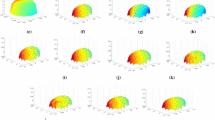Summary
Mathematically simulated data is used to obtain direct comparisons of the accuracies of spline/Laplacian and cortical imaging algorithms in predicting cortical potential. Even though the two approaches have quite different theoretical bases, the two methods provide nearly identical estimates of cortical activity at scales greater than about 2 or 3 cm when 64 electrodes are used.
Similar content being viewed by others
References
Cadusch, P.J., Breckon, W. and Silberstein, R.B. Spherical splines and the interpolation, deblurring and transformation of topographic EEG data. Pan Pacific Workshop on Brain Electric and Magnetic Topography, Melbourne, Australia, Feb. 17–18, 1992.
Gevins, A.S. Analysis of multiple lead data. In: J.W. Rohbraugh, R. Parasuraman, J.R. Johnson (eds.), Event-Related Brain Potentials. New York: Oxford University Press, 1990: 44–56.
Gevins, A. What is ailing electroencephalography and clinical neurophysiology and what are we doing to treat it? 3rd International Congress on Brain Electromagnetic Topography, Amsterdam; June 9–12, 1992.
Gevins, A.S., Brickett, P., Costales, B., Le, J. and Reutter, B. Beyond topographical mapping: towards functional-anatomical imaging with 124 channel EEGs and 3-D MRIs. Brain Topography, 1990, 3: 53–64.
Gevins, A.S. and Cutillo, B.A. Signals of cognition. In: F.H. Lopes da Silva, W. Storm van Leeuwen, A. Rémond (eds.), Handbook of Electroencephalography and Clinical Neurophysiology, Revised series. Vol. 2. New York: Elsevier, 1986: 335–381.
Hjorth, B. An on-line transformation of EEG scalp potentials into orthogonal source derivations. Electroencephal. Clin. Neurophysiol., 1975, 39: 526–530.
Katznelson, R.D. EEG recording, electrode placement, and aspects of generator localization. In: P.L. Nunez, Electric Fields of the Brain: The Neurophysics of EEG. New York: Oxford University Press, 1981.
Kearfott, R.B., Sidmann, R.D., Major, D.J. and Hill, C.D. Numerical tests of a method for simulating electrical potentials on the cortical surface. IEEE Trans. Biomed. Eng, 1991, 38: 294–299.
Law, S.K., Nunez, P.L. and Wijesinghe, R.S. High resolution EEG using spline-generated surface Laplacians on spherical and ellipsoidal surfaces. IEEE Trans. Biomed. Eng., 1993, 40: (Feb).
Law, S.K. Spline generated surface Laplacian estimates for improving spatial resolution in electroencephalography. Ph.D. Dissertation, Tulane University, 1991.
Nunez, P.L. Electric Fields of the Brain: The Neurophysics of EEG, New York: Oxford University Press, 1981.
Nunez, P.L. Estimation of large scale neocortical source activity with EEG surface Laplacians. Brain Topography, 1989, 2: 141–154.
Nunez, P.L. Spatial filtering and experimental strategies in EEG. In: D. Samson-Dollfus (ed), Statistics and Topography in Quantitative EEG. Paris: Elsevier, 1988: 196–209.
Nunez, P.L. Localization of brain activity with electroencephalography. In: S. Sato (ed), Advances in Neurology: Vol. 54 Magnetoencephalography. New York: Raven Press, 1990: 39–65.
Nunez, P.L. and Pilgreen, K.L. The spline-Laplacian in clinical neurophysiology: a method to improve EEG spatial resolution. J. Clin Neurophysiol., 1991, 8: 397–413.
Nunez, P.L., Pilgreen, K.L., Westdorp, A.F., Law S.K. and Nelson, A.V. A visual study of surface potentials and Laplacians due to distributed neocortical sources: computer simulations and evoked potentials. Brain Topography, 1991, 4: 151–168.
Perrin, F., Pernier, J., Bertrand, O., Giard, M.H. and Echallier, J.F. Mapping of scalp potentials by surface spline interpolation. Electroenceph. Clin. Neurophysiol., 1987, 66: 75–81.
Perrin, F., Pernier, J., Bertrand, O. and Echallier, J.F. Spherical splines for scalp potential and current density mapping. Electroenceph. Clin. Neurophysiol., 1989, 72: 184–187.
Yan, Y., Nunez, P.L. and Hart, R.T. A finite element model of the human head: scalp potentials due to dipole sources. Med & Bio Eng & Comput., 1991, 29: 475–481.
Author information
Authors and Affiliations
Additional information
Research at Tulane University was supported by NIH grant RO1 NS243314. Research at the Swinburne Centre for Applied Neurosciences was supported by an ARC research infrastructure grant. The authors thank Geoff Nield (in Melbourne), Andrew Westdorp (in New Orleans), and Sam Law (in Bethesda) for technical assistance.
Rights and permissions
About this article
Cite this article
Nunez, P.L., Silberstein, R.B., Cadusch, P.J. et al. Comparison of high resolution EEG methods having different theoretical bases. Brain Topogr 5, 361–364 (1993). https://doi.org/10.1007/BF01128691
Accepted:
Issue Date:
DOI: https://doi.org/10.1007/BF01128691




